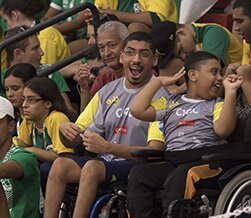Age at the Youth Parapan Am Games: 13-19 years
Practiced by athletes with cerebral palsy or similar severe disabilities, boccia was first played in Brazil in the 1970s. The sport consists of throwing coloured balls as close as possible to a white ball (jack). Athletes sit in wheelchairs and must remain inside a designated throwing area throughout the match. Competitors can use their hands, feet and assistive devices, as well as receiving help from assistants in the case of athletes with an insufficient range of movement in their arms and legs. The sport replaced lawn bowls, a form of boccia played on a bowling green which used to be a part of the Paralympic Games.

In terms of functional classification, athletes are arranged into four classes according to the extent of their disability and need for assistance (from BC1 to BC4). Athletes with more severe disabilities are allowed to use a ramp to throw the ball with more speed. For example, tetraplegic athletes, those who are unable to move their arms or legs, use special headgear with a pointer attached. The assistant positions the ramp in front of the athlete so he/she is able to push the ball using the pointer. In some cases, the ramp assistant is a parent of the athlete.





